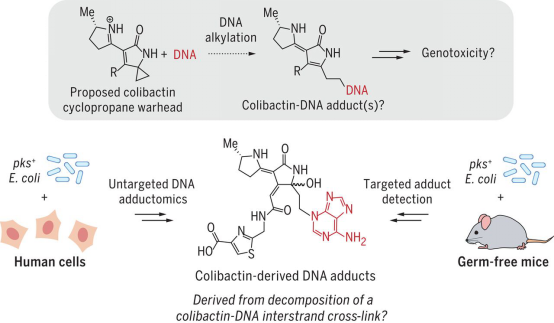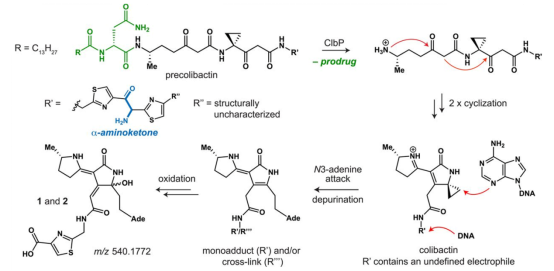Recently, researchers at Harvard University and the University of Minnesota published an article entitled "The human gut bacterial genotoxin colibactin alkylates DNA" in the journal Science on the mechanism by which intestinal bacterial toxins disrupt double-stranded dNA. They used chemical synthesis, mouse experiments, and omics analysis based on non-targeted mass spectrometry to study the mechanism of DNA damage in human living cells by colibactin, providing chemical and carcinogenic activity for colibactin. Direct evidence provides a potential novel marker for clinical detection of human colorectal cancer (CRC).

DNA alkylation gene toxin produced by E. coli associated with CRC
Studies have shown that some members of the human gut microbiota are associated with the development of CRC, which can cause cancer through a variety of mechanisms such as the production of genetic toxins. Colibactin is a genotoxic secondary metabolite synthesized from microorganisms containing pks genomic islands, including certain intestinal symbiotic Escherichia coli. Transient infection of mammalian cells with pks+ E. coli leads to cell cycle arrest and DNA double-strand breaks. In addition, E. coli producing colibactin was found to accelerate tumor progression in a plurality of colitis-associated CRC mouse models, and this phenomenon is also abundant in patients with familial adenomatous polyposis and CRC. Despite its strong association with cancer, it is difficult to isolate active virulence metabolites, limiting the understanding of this association mechanism.
Over the past decade, researchers have studied indirect information about the chemical structure of colibactin through a variety of complementary methods. Isolation and structural characterization of the metabolites of the pks+ E. coli mutant showed that colibactin may contain a cyclopropane ring, which is a reactive group in DNA alkylation-based damage agents, so the researchers hypothesized that colibactin uses DNA to carry out the cyclopropane group. Covalent modification.
To obtain information about the chemical structure of the active genoxin and its mode of action, the researchers identified the colibactin-DNA adduct in human cells infected with pks+E. coli and characterized it structurally. Using a non-targeted LC/MS technique for DNA adduct omics analysis, two adenine additions were discovered by comparing DNA adducts in mammalian cell lines transiently infected with pks+ or pks-E. coli. These adducts are only present in cells that are exposed to pks + E. coli. These adducts were confirmed to be associated with pks by isotopically labeled colibactin precursor compound feeding experiments. The above adducts are detected when human cells are exposed to clinically isolated E. coli which produces colibactin, or to colonic epithelial cells of mice treated with pks + E. coli. It was found by structural characterization that the adduct is a mixture of two diastereomers and both contain a 5-hydroxy-2-pyrrolidone structure linked to an N3-substituted adenine ring. After analysis, these DNA adducts were produced by ring-opening addition of a cyclopropane group. Because the adduct was too small to be obtained, the researchers detected Colibactin-DNA interchain cross-linking complexes in cells infected with pks+E. coli by CometChip analysis, which were confirmed by structural characterization to be larger. The unstable crosslinked complex decomposes.

Model of Colibactin DNA alkylation and DNA adduct formation
In addition, the ability of pks+E. coli to produce DNA adducts in mammalian cells and mice enhances the promotion of colibactin to cancer development; large interchain cross-linking adducts are cytotoxic, if not accurately repaired Lead to mutations. Thus, Colibactin-mediated DNA damage and the resulting genomic instability may be a potential cause of colorectal cancer. This study directly demonstrated the alkylation process of the intestinal bacterial gene toxin colibactin in vivo to double-stranded DNA, providing a theoretical basis for the study of CRC caused by colibactin. (Compiled from Science, Published: 15 February 2019)
Source: Ministry of Science and Technology website
Children's masks, medical surgical disposable children's medical masks, three-layer masks, unique packaging for girls and boys, and for children. Buy masks, certify us, and guarantee authenticity. Three-layer filtration, medical quality. Three-dimensional protection, multi-layer filtration, medical quality, breathable and skin-friendly. Plastic nose clip. The outer non-woven fabric blocks droplets, dust, etc., so that every breath of the child is more at ease. Intermediate filter cloth, flannel cloth filter particles, bacteria, etc. The inner non-woven fabric is skin-friendly, comfortable and more breathable.
China Kids Nonwoven Mask,Protective Disposable Face Mask manufacturers, welcome Anti Dust Activated Disposable Face Mask,Protective Children Face Mask purchasers from worldwide to visit our site.
Kids Nonwoven Mask,Protective Disposable Face Mask,Anti Dust Activated Disposable Face Mask,Protective Children Face Mask
KUTA TECHNOLOGY INDUSTRY CO.,LIMITED , https://www.kutasureblue.com